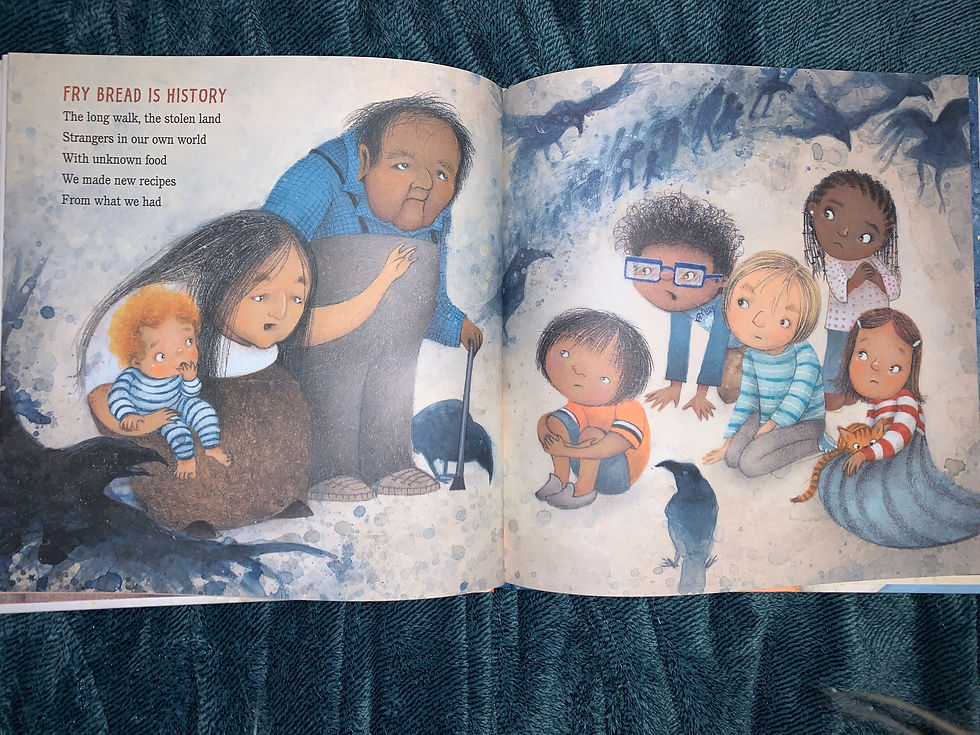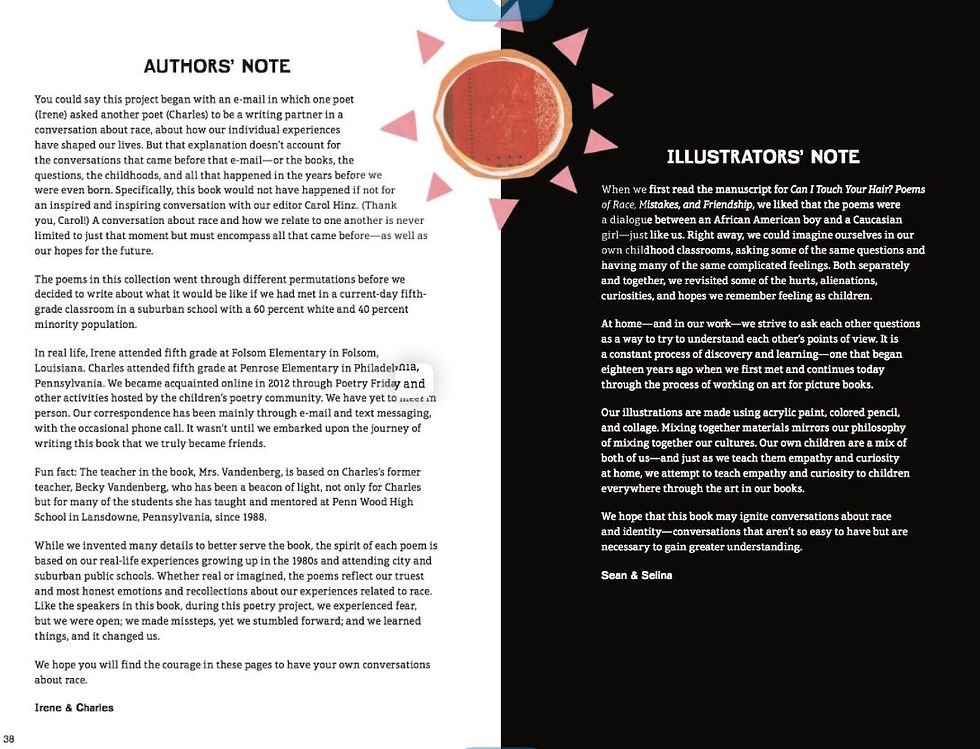Contemporary Counter Narratives
- harrisonse
- Oct 14, 2020
- 5 min read
Updated: Oct 16, 2020

In this book written by Kevin Noble Maillard and illustrated by Juana Martinez-Neal, a beautiful story is told about Native American culture using fry bread as a metaphor for their culture. Throughout the book fry bread is said to be time, art, history, and many other things as they use it as a vessel to share information about their culture to the reader. You are able to see into the world of Indigenous people through this story, you can see how cooking brings them together, how it reminds them of their challenging history, and how it represents their home through the carefully written text and the beautifully created illustrations.
The author, Kevin Noble Maillard, is a member of Seminole Nation, making him an #OWNVoices author. While I was reading an interview with the author I discovered that Maillard realized how underrepresented Native culture was in children’s literature and wanted to create an authentic text for his son and other members of the Native community. I loved how normalized Indigenous people were in this book compared to how they are traditionally represented in children’s books, which is either as Indians or incorporated into a unit centered around Thanksgiving. Since the author is a part of the Native community, I trust that the information in this text is authentic because he was sharing his experiences about something that was valued in his family. One thing that I almost did not notice was the writing on the endpapers. When I looked closer I realized that he had listed different Native Nations on the endpapers. Maillard did this because he wanted anyone who was a part of any Native Nation to feel represented and seen in this book and I think this was definitely achieved. He shared that those who have read his book have shared pictures of them pointing to their Nation, which was an emotional experience for them because they are rarely if ever represented in children’s books. In addition to the endpapers, the author's note at the end of the book stood out to me. I loved how he broke down each section of the book and explained it further to increase the reader's understanding. The author goes into depth about his experiences and the true meaning behind each page of the book. This would be great to explore with all students, but especially those who struggle to take away the big picture from this book.
Here is a picture of the illustration I discussed in my vlog:

For more information about the author visit the link below:
Kevin Noble Maillard: https://www.kevinmaillard.com/
Interview with the Author: https://cynthialeitichsmith.com/2019/11/native-voices-kevin-noble-maillard-on-writing-fry-bread/
Book Awards:
Winner of the 2020 Robert F. Sibert Informational Book Medal
A 2020 American Indian Youth Literature Picture Book Honor Winner

Can I Touch Your Hair, written by Irene Latham and Charles Waters, illustrated by Sean Qualls and Selina Alko, discusses several stereotypes about African Americans by using poetry to share their experiences. A few of the stereotypes that are touched on throughout this book are being good at basketball, having different hair that is yours to touch, struggling academically, and being dangerous. You can also see instances where one of the main characters is discriminated against because of her color, her white classmates saying that she needs to play somewhere else or asking why she tries to be like them just because she spoke properly and did well in school. In addition to these instances, several other experiences are described that African Americans unfairly face often in life, like police brutality. Telling about these experiences through poetry allowed the authors to share so many different experiences to enlighten the reader on the unjust things other race’s are forced to deal with, which may not have been as effective if told through a typically written children’s book.
Throughout this story the reader is able to see a wide variety of unjust instances that African Americans face across a wide variety of settings. We did not only see how they are discriminated against in school but in other areas as well, showing us how these things affect them everywhere they go. At school they may be judged because of how they look, for the way they speak, or because of incorrect stereotypes that have been outspoken in our society, all of which are experiences portrayed through the poems in this book. Outside of school they may be viewed as dangerous, which can be seen in the page I am including below. The poem prior to this one discussed how a child’s parents would not let her go to her friend’s house because it was dark and in a dangerous part of town. What they meant by that was that it was in a part of town where African Americans live and they cannot be trusted because they are dangerous. I was outraged while reading this because sadly this is something that our society seems to believe. As I progressed to the next page I absolutely loved this poem (pictured below) because it portrayed this inaccurate stereotype in such a powerful way. This poem could stand on its own because of how the illustrations and the words work together to tell an incredibly important story.

Although they are so often judged because of these stereotypes, one good point was made in the book; “Why do people who want to look like me hate me so much” (p. 12)? I liked this quote because of the truth behind it. White people may do their hair ways that are common among the African American community, or listen to music written by African Americans, but they are still unwilling to accept them, why? This book shows the audience so many instances where members of the African American community feel inferior or discriminated against that white people do not have to experience because of their privilege. Through telling about these unjust experiences, the author essentially debunked them through their poems about the main character who was African American. She did well in school, she spoke properly, she was kind and accepting, she was just like any other child the only difference was the color of her skin. In the poem I am including below you can see how these stereotypes are refuted as one student apologizes for the hurtful words he said.

For more information about the authors visit the links below:
Irene Latham: https://www.irenelatham.com/
Charles Waters: https://www.charleswaterspoetry.com/
For more information about the illustrator visit the link below:
Sean Qualls: https://www.seanqualls.com/#/
Selina Alko: It appears that her website is currently under construction, but check back in the future to check it out!
Author and Illustrator Notes from the Book:

Other Resources:
Animated Film: Hair Love
Here I am including a list of books that Debbie Reese included at the end of her article "Critical Indigenous Literacies: Selecting and Using Children's Books about Indigenous Peoples" that would be beneficial to share with students that were written by Native Authors:
Baker, D. (2016). Kamik joins the pack (Q. Leng, Illus.). Iqaluit, Nunavut: Inhabit Media.
Dimaline, C. (2017). The marrow thieves. Toronto, Ontario: Cormorant Publishers.
Gansworth, E. (2013). If I ever get out of here. New York, NY: Arthur A. Levine Books.
Herrington, J. (2016). Mission to space. Ada, OK: White Dog Press.
Marshall, J., III. (2015). In the footsteps of Crazy Horse (J. M. Yellowhawk, Illus.). New York, NY: Harry N. Abrams.
Minnema, C. K. (2014). Hungry Johnny (W. Ballinger, Illus.). Saint Paul, Minnesota: Historical Society Press.
Ortiz, S. J. (2017). The people shall continue (S. Graves, Illus.). New York, NY: Lee and Low Books.
Robertson, D. A. (2016). When we were alone (J. Flett, Illus.). Winnipeg, Manitoba: HighWater Press.
Robertson, J. (2017). The water walker. Toronto, Ontario: Second Story Press.
Robertson, S. (2014). Rock and roll highway: The Robbie Robertson story (A. Gustavson, Illus.). New York, NY: Henry Holt.
Smith, M. G. (2017). You hold me up (D. Daniel, Illus.). Victoria, British Colombia: Orca Book Publishers.



Comments